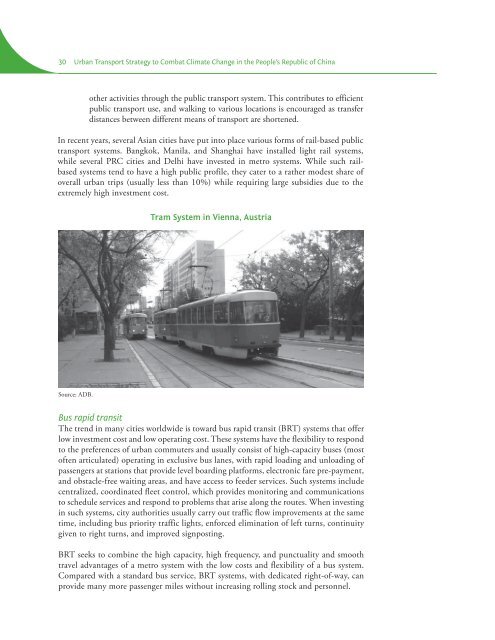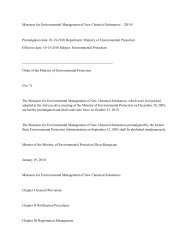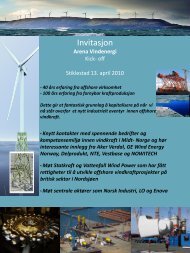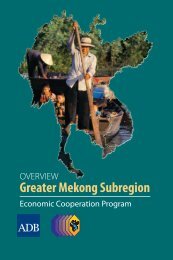Best Practices for Sustainable <strong>Transport</strong> Initiatives 29reasons), or the low-emission zone system may be permanent. Some cities ban trucks atcertain times of the day. In Germany, this now applies to older vehicles that do not meetcurrent emission standards. Owners of such vehicles must trade them in for new onesthat meet the standards or switch to public transport. However, low-emission zones arerather costly and demanding in terms of monitoring and enforcement, both in terms ofstaff and technological equipment.Traffic managementTraffic management measures include sophisticated traffic signal systems (area trafficcontrol systems) to secure steady traffic flows. This can significantly increase the carryingcapacities per lane of the affected streets, and thus reduce congestion and increase speed.This will in itself reduce fuel use and GHG emissions for existing traffic, even if carvolumes are not reduced. However, it also makes car use more attractive, so that car useincreases. The net GHG emission effect may, therefore, be small, perhaps even negative.In Organisation for Economic Co-operation and Development countries, such systemshave led to 2%–5% emission reductions overall. In cities in developing countries, wherethe initial (baseline) situation is much worse, the potential GHG savings could be muchhigher. If combined with travel demand management measures and parking supplyrestrictions, the overall GHG-reduction effects could be very substantial and significantplanned road infrastructure investments could be postponed or avoided.Planning for and Promoting Attractive Public <strong>Transport</strong>Several countries have promoted the use of public transport to be able to attract users.Some examples of measures adopted by different countries are as follows:• France: Attach importance to connection, transfer, and service quality. Asearly as the 1970s, the Government of France gave priority to the developmentof public transport. The city government of Paris has adopted manyappropriate measures, such as constructing a “model transformation center.”The center improves the condition of public transport facilities by improvingspace design in stations or hubs, making efficient time schedules, developinginterconnectivity of subway operations with other public transport services, andpromoting integrated ticketing to raise the utilization rate of public transport.• Germany: Use joint operation mechanism for regional public transport.In Germany, operation of public transport is jointly managed by the publicand private sectors. Intra-city travel in German cities is usually connected bytrams, light rail, and buses. The light rail system is owned by a public transportcompany, while buses may belong to different operators, usually privately heldor owned, based on routes. Public transport services are seamlessly operated incooperation with the private sector.• Singapore: Adopt measures of three-dimensional transferring and multimodalcoordinated transport. Door-to-door transport and seamless connection serviceshave been promoted strongly in Singapore. By introducing comprehensivetransfer centers, coordinated multimodal transport, and efficient ticket-pricemanagement, the government was able to closely connect work, shopping, and
30 <strong>Urban</strong> <strong>Transport</strong> Strategy to Combat Climate Change in the People’s Republic of Chinaother activities through the public transport system. This contributes to efficientpublic transport use, and walking to various locations is encouraged as transferdistances between different means of transport are shortened.In recent years, several Asian cities have put into place various forms of rail-based publictransport systems. Bangkok, Manila, and Shanghai have installed light rail systems,while several PRC cities and Delhi have invested in metro systems. While such railbasedsystems tend to have a high public profile, they cater to a rather modest share ofoverall urban trips (usually less than 10%) while requiring large subsidies due to theextremely high investment cost.Tram System in Vienna, AustriaSource: ADB.Bus rapid transitThe trend in many cities worldwide is toward bus rapid transit (BRT) systems that offerlow investment cost and low operating cost. These systems have the flexibility to respondto the preferences of urban commuters and usually consist of high-capacity buses (mostoften articulated) operating in exclusive bus lanes, with rapid loading and unloading ofpassengers at stations that provide level boarding platforms, electronic fare pre-payment,and obstacle-free waiting areas, and have access to feeder services. Such systems includecentralized, coordinated fleet control, which provides monitoring and communicationsto schedule services and respond to problems that arise along the routes. When investingin such systems, city authorities usually carry out traffic flow improvements at the sametime, including bus priority traffic lights, enforced elimination of left turns, continuitygiven to right turns, and improved signposting.BRT seeks to combine the high capacity, high frequency, and punctuality and smoothtravel advantages of a metro system with the low costs and flexibility of a bus system.Compared with a standard bus service, BRT systems, with dedicated right-of-way, canprovide many more passenger miles without increasing rolling stock and personnel.











